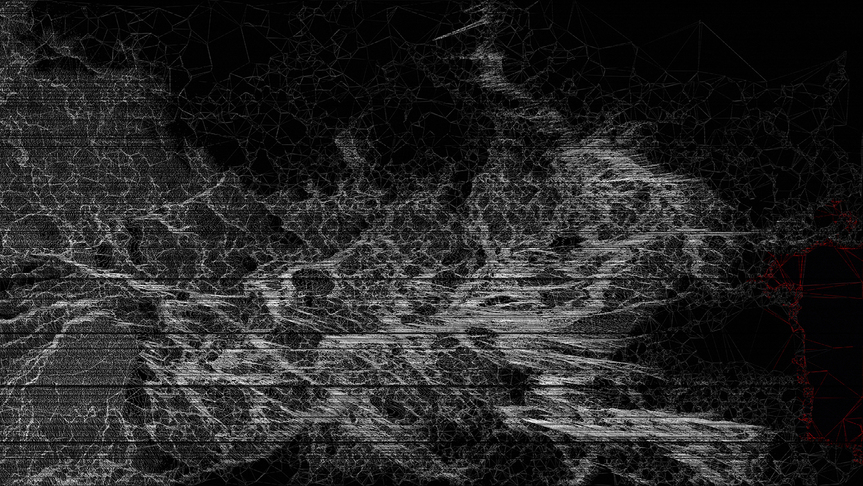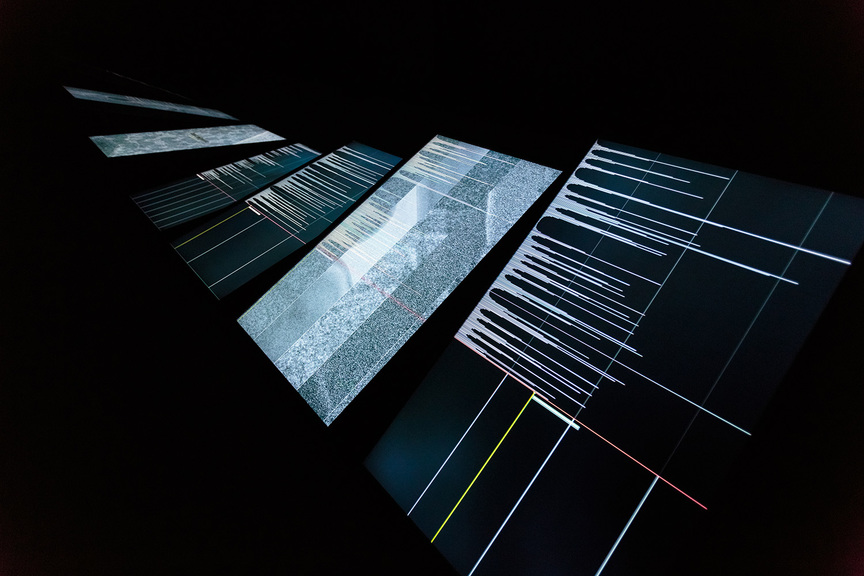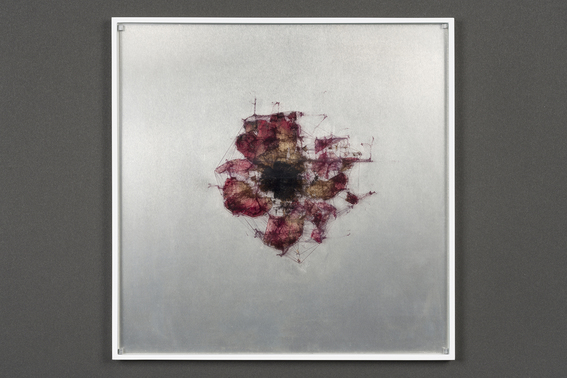-
From Current Issue
-
- Editor’s Letter Fire in the Heart
- Reviews I Gusti Ayu Kadek Murniasih
- Reviews 11th Seoul Mediacity Biennale: “One Escape at a Time”
- Dispatch Networked China
- One on One Monira Al Qadiri on Yukio Mishima
- Essays The rise of independent art spaces in pandemic-era Shanghai
- Features Tuan Andrew Nguyen
- Table of Contents
- Web Exclusives
- Archive
- Subscribe

R
E
V N
E
X
T
Installation view of RYOICHI KUROKAWA’s ad/ab Atom, 2017, audiovisual installation, seven-channel HD display, four-channel sound: 8 min (loop), at GNRation, Braga, 2017–18. Photo by Hugo Sousa. Copyright the artist. Courtesy GNRation, Braga.
The first Italian institutional solo show of Osaka-born, Berlin-based artist and musician Ryoichi Kurokawa brought a selection of his recent audio-visual projects, installations, sculptures and digital prints to the Galleria Civica di Modena. As a pioneer of generative art, Kurokawa is internationally renowned for fusing digital sound and imaging technologies to create synesthetic environments intended to alter the viewer’s experience of reality. The Arabic word al-jabr, in the title of the exhibition, means the reconstitution of fragmented parts, and is the origin of the mathematical term “algebra.” Apropos of this title, the deconstruction and reconstruction of elements from the natural world through advanced technology is one of the main methodological axes of Kurokawa’s artistic production, and this approach was reflected in the works on show.
Eight minutes of intense sonic and visual experience greeted visitors as they entered the darkened hall of the exhibition. Unfold.alt (2016), the show’s centerpiece, comprises an audio-visual projection in which the artist shows the lifespan of a star in reverse, from extinction to creation. An accompanying series of eight digital prints features images of three-dimensional models taken during the installation’s development. To create an artistic representation of the universe that is as scientifically accurate as possible, Kurokawa collaborated with Vincent Minier, an astrophysicist at the France-based Institute of Research into the Fundamental Laws of the Universe. Using data-processing software, the artist manipulated infrared images from the Hershel space telescope, as well as data from the Institute’s supercomputers that are used to generate simulations of natural phenomena. The projected sequence opens with a small, trembling, cell-like formation drifting in pitch-black space, gradually unfolding to trace the involution of the star to the sound of crackling static and acute interference noises, or digital rearrangements of white noise. The origins of phenomena such as turbulence, gravitational collapse, ionization and nuclear fusion are visualized in high-definition, twisting 3D models and animated graphs that soon evolve into tangled lines. Most impressive are the close-ups of a sun-like star, flaring out fiery tongues of gas into space before dissolving into a swarm of stellar dust with a rippling sound. Alternating fast and slow motion, darkness with blasts of color, Unfold.alt is a superbly choreographed spectacle where matter seems to be endlessly re-absorbing itself before the cycle begins anew.
Another immersive audio-visual environment, ad/ab Atom (2017), comprises seven high-definition, rectangular screens positioned face-up in a row on the floor, pivoting one by one on the same axis in an undulating configuration. The piece explores how nature on the nanoscopic level is ruled by quantum mechanics, and was based on images that were gathered during Kurokawa’s residency at the International Iberian Nanotechnology Laboratory in Braga, Portugal. These pictures were distorted and merged with one another to create ultra-magnified, imaginary elaborations of the atomic world. Intricate cobweb-like patterns and molecular life forms onscreen are zoomed into at high speed to a fast-dropping countdown timer. The screens glitch and flicker intermittently; crackling noises alternate with digitally processed sound modulations boosting from loudspeakers at each corner of the room, adding to the disorienting and slightly anxiety-provoking experience.
The Japanese Oshibana art of using pressed and desiccated flowers to create pictures inspired Elementum (2018), a minimalistic series of mixed-media works on glass mounted on four white plinths, recalling display cases in a museum. Reworking tradition, Kurokawa connects dried fragments of flower petals and leaves with digitally rendered webs of fine lines in delicate compositions infused with the ancient wabi-sabi aesthetic philosophy, which welcomes transience and the natural cycle of decay as an element of beauty. Linking directly to the show’s theme of al-jabr, these fragmentary pieces hint at the essential interconnectedness of all life.
Though presenting a relatively small selection of works, “Al-Jabr (Algebra)” was a challenge for the imagination. Kurokawa’s creative application of advanced technology to dis- and reassemble natural phenomena not only offers uncommon sensorial experiences, but also fresh ways of observing and contemplating reality.
Ryoichi Kurokawa’s “Al-Jabr (Algebra)” is on view at the Galleria Civica di Modena – Palazzo Santa Margherita, Modena, until February 24, 2019.
To read more of ArtAsiaPacific’s articles, visit our Digital Library.


















